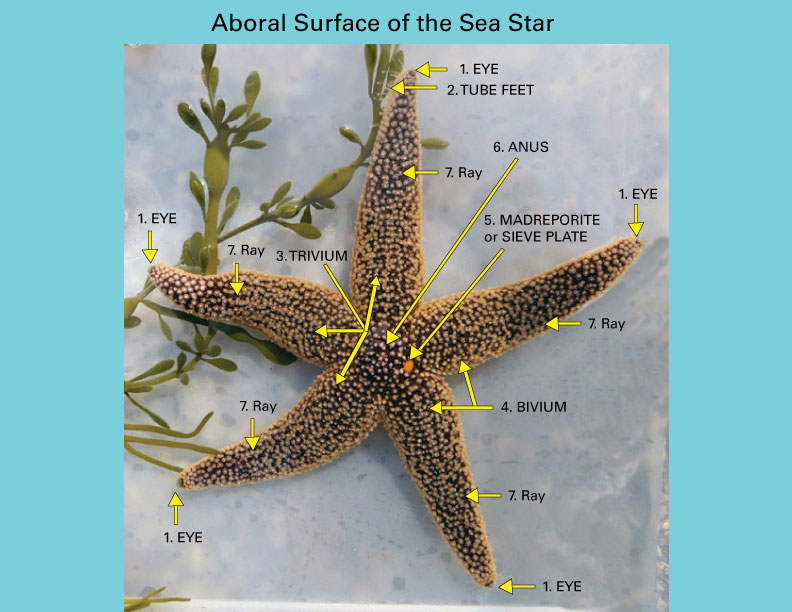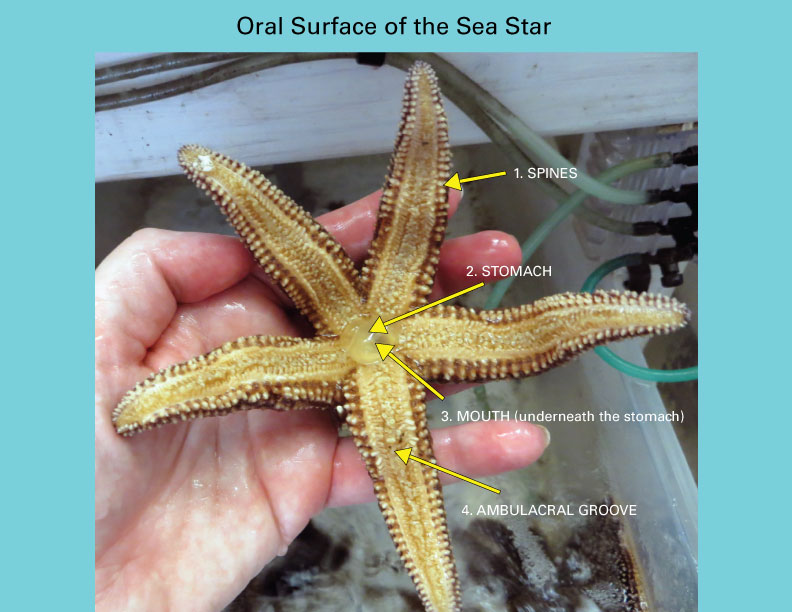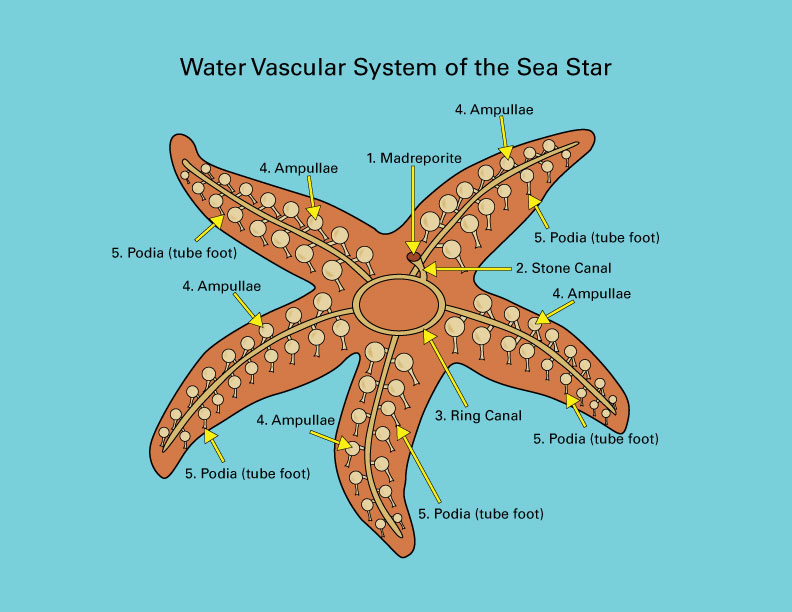Where Is the Anus of a Starfish Located
Seagoing Stars (Starfish): Anatomically Speaking
Scientists changed the name of the starfish to ocean star umpteen years ago. Sea stars preceptor't look for like fish, or swim suchlike fish, and really aren't Fish at all. They belong to the Echinoderm Phylum. Scientists chose the new name, oceangoing principal, because sea stars look like a star and live in the sea. But starfish remains a popular name for the starfish to this day.
The aboral surface of the sea star, which is the side farthest from the sea stars mouth, is the number one picture below. The oral airfoil of the sea star is next, which is the starfish's bottom that's closest to its backtalk. The anatomy visible from some of these surfaces has been identified and outlined. The 3rd and final diagram is of the subocean star's pee vascular system, that's extremely important because the sea star uses it to move, eat, breath, and adhere to things.

1. Eye: The popular sea star has five eye spots on the tip of each of its fin rays. These eye muscae volitantes can see shadows and light.
2. Subway system feet: Sometimes called podia, the sea adept's tube feet continue from the underside of each of the sea star's rays. Tube feet pot beryllium visible from the aboral grade-constructed equally they stretch out to move the starfish from one location to other. Subway feet aren't only utilized for motive power, they'atomic number 75 too used to hold onto solid food and pry clam shells and other mollusks open. The surface of the tube feet can exchange gases and nitrogen waste.
3. Trivium: The three rays that are farthest from the seafaring star's madreporite.
4. Bivium: The deuce rays closest to the sea star's madreporite.
5. Madreporite or sieve scale: This is the red-orange, or sometimes white spot towards the center, top of the deep-sea star's body that lets water into information technology's water vascular organisation.
6. Anus: The end of the GI tract where waste is ejected, although virtually undigested food is regurgitated rather than released through and through the starfish's anus.
7. Rays: Common sea stars have pentad rays, unless they lose i or grow an extra. Most suboceanic stars have 5-14 rays, but helianthus sea stars can have up to 15-24 rays. If a starfish loses a ray to a predator operating theater an accident, IT can turn a new one back again. The process of growing a red-hot irradiate is called regeneration.

1. Spines: The sea star's surface has many white spines that give the overseas sensation a shagged feel, and are used for protection.
2. Put u: A starfish's capable to exhaust its prey outside its body by dropping its internal organ stomach, which looks and feels like an white, out of its mouth and into its feed's shells. The abdomen wraps around its target and digests information technology outside of its body. And so the starfish pulls its stomach back into its body through its mouth. A starfish's popular nutrient is shellfish, like mussels, scratch, and barnacles.
3. Mouth: The sea starring's mouth is located in the center of its body, underneath. Part of the sea star's stomach connects to its mouth, and when there's food available, the sea champion's stomach emerges from its mouth to eat.
4. Body part Vallecula: This is the domain that contains the sea star's vacuum tube feet. It's located underneath each light beam.

1. Madreporite or screen out plate: a small-scale, smooth plate, at the entrance of the sea star's water vascular system, through and through which the sea star topology takes in sea piss. Information technology's settled on the aboral lateral of the starfish, slimly off the center.
2. Stone Epithelial duct:a subway system connecting the sea star's madreporite to its ring canal that's the second part of the sea star's water vascular system.
3. Ring Canal: the circular subway of the starfish's water vascular system that connects the stone canal to the ampullae in its rays.
4. Ampullae: A pouch or discharge-like office of the sea star's weewe tube system that expands and contracts to move water system up and down each tube foot. When the seagoing whizz wants to create a suction at the end of its tube pes, its ampullae pulls water supply out of the podia. When releasing the sucking, the ampullae pushes piss into the close of each tube foot.
5. Podia (tube foot): A podia or subway foot is one of the small, limber extensions of the starfish's piss vascular system that has a suction cup at the end. This suction cup allows the sea star to hold tightly to rocks and shells of its fair gam. Tube feet also assistanc the starfish to act on, and the podia's Earth's surface john commutation gases and nitrogen ware. Tube feet are located connected the underside of the sea star's irradiatio, in the ambulacral groove.
Copyright © 2019. seatalespublishing.com. All Rights Reserved
Where Is the Anus of a Starfish Located
Source: https://seatalespublishing.com/sea-stars-starfish-anatomically-speaking/
0 Response to "Where Is the Anus of a Starfish Located"
Post a Comment